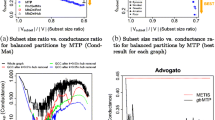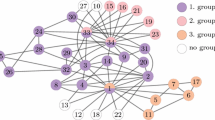Abstract
Maximum common induced subgraph (MCIS) of a communication network graph database determine the common substructures which are always active and retain the links between any pair of nodes exactly as in all graphs of the database. Many benchmark graph algorithms to predict MCIS of a graph database deal only with two graphs at a time and seek isomorphism, for which a high computational cost is to be paid. This gradually reduces the performance of the existing algorithms when the database has huge graph data. The proposed binary caterpillar MCIS algorithm to predict all MCIS of the database works for communication network graph database each of whose vertices has a unique label (IP address). In this, a new data structure which is a caterpillar-based binary tree is defined to reduce the search space of the problem using the concept of vertex cover and it takes into account all graphs of the database simultaneously to predict all MCIS of the database. This has substantially reduced unwanted comparisons among the datasets, when compared to the existing algorithms, as well as the difficulty of seeking isomorphism is avoided due to unique vertex labels. The experimental results further ensure the efficiency of the proposed algorithm with respect to existing works.












Similar content being viewed by others
References
Aggarwal CC, Wang H (2010) Managing and mining graph data, vol 40. Springer, Berlin
Berlo RJV, Winterbach W, Groot MJD, Bender A, Verheijen PJ, Reinders MJ, Ridder DD (2013) Efficient calculation of compound similarity based on maximum common subgraphs and its application to prediction of gene transcript levels. International J Bioinform Res Appl 9(4):407–432
Bunke H, Foggia P, Guidobaldi C, Sansone C, Vento M (2002) A comparison of algorithms for maximum common subgraph on randomly connected graphs. In: Caelli T, Amin A, Duin RPW, de Ridder D, Kamel M (eds) Structural, syntactic, and statistical pattern recognition. Springer, Berlin, pp 123–132
Cao Y, Jiang T, Girke T (2008) A maximum common substructure-based algorithm for searching and predicting drug-like compounds. Bioinformatics 24(13):i366–i374
Clauset A, Newman ME, Moore C (2004) Finding community structure in very large networks. Phys Rev E 70(6):066,111
Conte D, Foggia P, Vento M (2007) Challenging complexity of maximum common subgraph detection algorithms: a performance analysis of three algorithms on a wide database of graphs. J Graph Algorithms Appl 11(1):99–143
Cook DJ, Holder LB (2006) Mining graph data. Wiley, London
Dickinson PJ, Bunke H, Dadej A, Kraetzl M (2004) Matching graphs with unique node labels. Pattern Anal Appl 7(3):243–254
El Emary IM, Al Rabia AI (2005) Estimation techniques for monitoring and controlling the performance of the computer communication networks. Am J Appl Sci 2(10):1395
Fu AY, Wenyin L, Deng X (2006) Detecting phishing web pages with visual similarity assessment based on earth mover’s distance (EMD). IEEE Trans Dependable Secure Comput 3(4):301–311
Gross JL, Yellen J (2004) Handbook of graph theory. CRC Press, Boca Raton
Han J, Cheng H, Xin D, Yan X (2007) Frequent pattern mining: current status and future directions. Data Min Knowl Disc 15(1):55–86
Hand DJ, Mannila H, Smyth P (2001) Principles of data mining. MIT Press, Cambridge
Koch I (2001) Enumerating all connected maximal common subgraphs in two graphs. Theor Comput Sci 250(1):1–30
Levi G (1973) A note on the derivation of maximal common subgraphs of two directed or undirected graphs. Calcolo 9(4):341–352
Llados J, Sanchez G (2004) Graph matching versus graph parsing in graphics recognitiona combined approach. Int J Pattern Recognit Artif Intell 18(03):455–473
McGregor JJ (1982) Backtrack search algorithms and the maximal common subgraph problem. Softw Practice Exp 12(1):23–34
McGregor JJ, Willett P (1981) Use of a maximum common subgraph algorithm in the automatic identification of ostensible bond changes occurring in chemical reactions. J Chem Inf Comput Sci 21(3):137–140
Palmer CR, Gibbons PB, Faloutsos C (2002) Anf: a fast and scalable tool for data mining in massive graphs. In: Proceedings of the eighth ACM SIGKDD international conference on knowledge discovery and data mining. ACM, pp 81–90
Raymond JW, Gardiner EJ, Willett P (2002) Heuristics for similarity searching of chemical graphs using a maximum common edge subgraph algorithm. J Chem Inf Comput Sci 42(2):305–316
Raymond JW, Willett P (2002) Maximum common subgraph isomorphism algorithms for the matching of chemical structures. J Comput-Aided Mol Des 16(7):521–533
Rutgers JH, Wolkotte PT, Holzenspies PK, Kuper J, Smit GJ (2010) An approximate maximum common subgraph algorithm for large digital circuits. In: 2010 13th Euromicro conference on digital system design: architectures, methods and tools (DSD). IEEE, pp 699–705
Vijayalakshmi R, Nadarajan R, Nirmala P, Thilaga M (2011) Performance monitoring of large communication networks using maximum common subgraphs. Int J Artif Intell 6(S11):72–86
Vijayalakshmi R, Nadarajan R, Nirmala P, Thilaga M (2011) A divisive clustering algorithm for performance monitoring of large networks using maximum common subgraphs. Int J Artif Intell 7(A11):92–109
Wang Y, Maple C (2005) A novel efficient algorithm for determining maximum common subgraphs. In: Ninth international conference on information visualisation, 2005. Proceedings. IEEE, pp 657–663
Yan X, Zhu F, Yu PS, Han J (2006) Feature-based similarity search in graph structures. ACM Trans Database Syst (TODS) 31(4):1418–1453
Author information
Authors and Affiliations
Corresponding author
Ethics declarations
Conflict of interest
The authors declare that they have no conflict of interest.
Rights and permissions
About this article
Cite this article
Nirmala, P., Lekshmi, R.S. & Nadarajan, R. Vertex cover-based binary tree algorithm to detect all maximum common induced subgraphs in large communication networks. Knowl Inf Syst 48, 229–252 (2016). https://doi.org/10.1007/s10115-015-0874-z
Received:
Revised:
Accepted:
Published:
Issue Date:
DOI: https://doi.org/10.1007/s10115-015-0874-z




